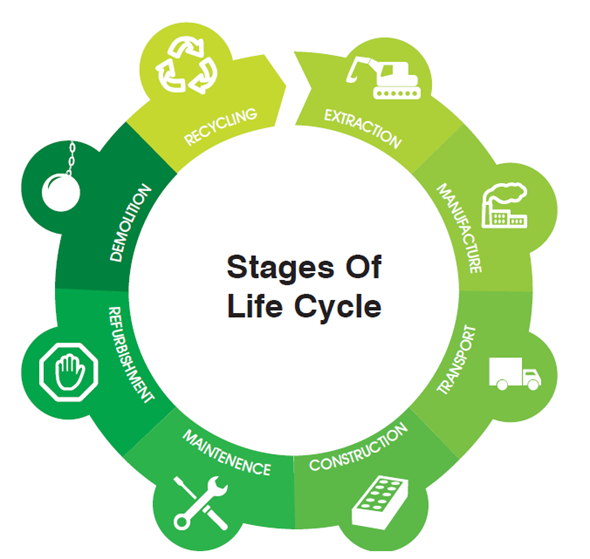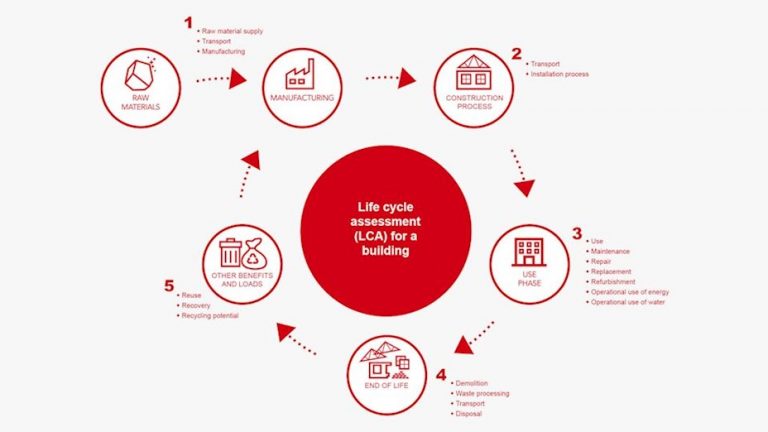Building Life Cycle Assessment in UAE (LCA), Building Life Cycle Assessment in Dubai, Building Life Cycle Assessment in Abu Dhabi, Building Life Cycle Assessment in Saudi, Building Life Cycle Assessment in Qatar, Building Life Cycle Assessment in Oman
What is Building Life Cycle Assessment (LCA)? Life cycle assessment (LCA) is one of the best mechanisms for allowing architects and other building professionals to understand the energy use and other environmental impact associated with all the phases of a building’s life cycle: procurement, construction, operation, and decommissioning.
”LCA results can help answer numerous questions that arise during the design and construction of a green building. It can reinforce the decisions taken by architects by providing a scientific justification.”

Architects are increasingly interested in reducing the environmental impact of the buildings they design. Tools like energy modeling assist in predicting and reducing energy use in buildings. Life cycle assessment (LCA) is one of the best mechanisms for allowing architects and other building professionals to understand the energy use and other environmental impact associated with all the phases of a building’s life cycle: procurement, construction, operation, and decommissioning. Building Life Cycle Assessment in UAE (LCA), Building Life Cycle Assessment in Dubai, Building Life Cycle Assessment in Abu Dhabi, Building Life Cycle Assessment in Saudi, Building Life Cycle Assessment in Qatar, Building Life Cycle Assessment in Oman
The output of an LCA can be thought of as a wide-ranging environmental footprint of a building — including aspects such as energy use, global warming potential, habitat destruction, resource depletion, and toxic emissions.
LCA is emerging as one of the most functional building and design assessment devices. This paper provides clear guiding principles, specifically directed toward the architectural profession, in the use of building LCA to help architects understand and use LCA methodology as part of the design process. It identifies scenarios for the use of LCA in the design process and provides a set of proposed guidelines for the conductance of whole-building LCA. Building Life Cycle Assessment in UAE, Building Life Cycle Assessment in Dubai, Building Life Cycle Assessment in Abu Dhabi, Building Life Cycle Assessment in Saudi, Building Life Cycle Assessment in Qatar, Building Life Cycle Assessment in Oman
We will talk about different concepts of the product lifecycle in just a moment, but generally speaking, the product lifecycle consists of five phases: Raw Material Extraction. Manufacturing & Processing. Transportation
There are many factors that must be considered before evaluating claims that one or another building type or product offers a better environmental return. To understand the full environmental impact of a structure over decades of use, all phases, starting before construction and continuing through demolition, must be considered. Life cycle assessment (LCA) seeks to quantify the environmental impacts over the infrastructure life cycle by identifying the costs during each phase.
LCA can be used to obtain credits in certification systems like LEED, but traditional LCA methods can be time, resource, and data-intensive. For complex systems like residential buildings, these demands can lead to delayed assessments with evaluations carried out after important design decisions have already been made, reducing their effectiveness. Our researchers have developed a streamlined approach to LCA that requires significantly less time and data, which can reduce expense as well as uncertainty and allow assessments to be conducted earlier in the building design process when decisions can have the greatest impact. Building Life Cycle Assessment in UAE, Building Life Cycle Assessment in Dubai, Building Life Cycle Assessment in Abu Dhabi, Building Life Cycle Assessment in Saudi, Building Life Cycle Assessment in Qatar, Building Life Cycle Assessment in Oman

A whole building life cycle assessment (LCA) was performed on a Living Building, focusing on impacts from green building materials, a decentralized water system, a net-positive use phase, and the end-of-life of structural materials. The material processes used in this LCA were adjusted from standard to green by removing the use of toxic chemicals; results show carcinogenic impacts decreased by up to 96%. The septic system used for wastewater treatment contributes to 41% of the global warming potential [GWP, kg CO2eq (carbon dioxide equivalent)] over the building’s assumed 100-year lifespan due to methane emissions. The on-site solar panels generate more electricity than the site demands, allowing for 44,000 kWh of green energy to be returned to the grid based on 1 year of performance. Lastly, an exploratory scenario analysis performed on multiple waste streams for structural materials shows that the GWP impacts for the end-of-life could vary from +14,000 to −10,500 kg CO2eq depending on the waste stream. The results of this LCA indicate that the case study building is net-zero energy and water, but not net-zero carbon. Building Life Cycle Assessment in UAE, Building Life Cycle Assessment in Dubai, Building Life Cycle Assessment in Abu Dhabi, Building Life Cycle Assessment in Saudi, Building Life Cycle Assessment in Qatar, Building Life Cycle Assessment in Oman
For Environmental Product Declaration in GCC (EPD), refer to https-www-envirolink-me-environmental-product-declarations-epd/
For Health Product Declaration in GCC (HPD), refer to https://www.envirolink.me/health-product-declarations-hpd/
For our other solutions we offer in Middle-East, please click https://www.envirolink.me/solutions/
